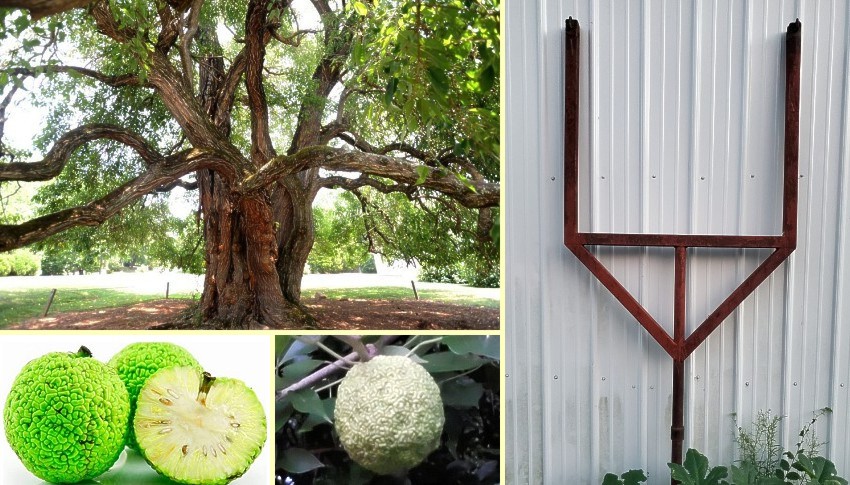Kansas Snapshots by Gloria Freeland - September 3, 2021
How do you like those (hedge) apples?
Question: What was once found only in Oklahoma, Arkansas and Texas, but is now at home in almost every state, largely thanks
to President Franklin Roosevelt?
Here are some hints: It produces something early French traders called bois d'arc and explorer Meriwether Lewis, of Lewis and
Clark expedition fame, said members of the Osage Nation traveled great distances for.
The answer? It's the Maclura pomifera, the sole survivor of the genus Maclura and member of the mulberry family. Most of us
would call it a hedge tree!
Part of Roosevelt's New Deal of the 1930s included the Shelter Break Project - a response to soil erosion during the Dust Bowl.
Unemployed workers were hired to plant more than 200 million hedge trees, many of which are still growing today.
Native Americans had long before discovered that its strong, flexible wood made high-quality bows, hence bois d'arc - bow-wood.
When white settlers arrived, they found it to be a mixed blessing. As a fire wood, it was prized. It is very dense and so burns
hot and slow. Prior to the 1874 invention of barbed wire, rows of hedge trees, with their sharp thorns,
were effective in containing livestock. The wood was also used for wagon wheels and railroad ties, owing to its strength,
hardness and resistance to rotting. But its density also made it hard to light, hard to cut and resistant to accepting staples.
We had a long row of hedge trees on the western edge of our farm property when I was a youngster and it was the fruit that
intrigued me. Although the hedge apples - also called hedge balls, horse apples, mock oranges or Osage oranges - aren't
suitable for human consumption, the bright green color still catches my eye.
Settlers thought the knobby balls kept insects away, but researchers at Iowa State University found that while a chemical
compound in the fruit does seem to repel cockroaches, the effect is weak and some people might be allergic to the sticky
white substance inside.
Recently, husband Art and I were driving through Iowa, when he pointed out some hedge trees, covered with the large green orbs.
He told me he had never seen one until he moved to Kansas as they are only found a few places along his native Wisconsin's
southern border.
This surprised me as they were an everyday part of my farm life.
Brother Dave remembers shooting them off our trees with his .22 rifle.
"They were very sticky and had white juice in them," he recalled.
Cousin Linda also remembered them from her growing-up years.
"Osage oranges - hedge apples- green popcorn balls! Yes, remember them well," she said. "Don't know if they were on our farm,
but I do remember mom spraying them gold for some kind of arrangement at a banquet or something. Kind of disgusting little
balls I thought. ..."
Linda's last comment may spring from the fact that the furrowed grooves on the fruit's outer layer look somewhat like the
surface of the brain.
I guess others must find them interesting as well, for I discovered online-store Etsy was selling four to six large Osage
oranges for $28.
This order will include at least 4 LARGE Bois D'arc Apples, and as many others as I can fit in the box. This fruit has so
many names!! Summer thru the fall (July - November) is the only time this fruit is available. ... Fresh from Texas, these
hedge apples can be used in autumn centerpieces, wreaths, or topiary! These fresh Osage oranges will be a stunning addition
to your decor! ... Our hedge balls range in size from slightly larger than a baseball to as large as a grapefruit! ...
Like Linda's mom, I also thought those knobby balls would look pretty in an arrangement, but I opted for the natural look,
rather than painting them gold. I combined them with acorns, pine cones, little pumpkins and miniature squashes and put them
into a wooden box on our front porch.
But they didn't last long. Most withered, but one had a more interesting fate. While humans don't eat them, squirrels do. One
day, I looked out on our deck and a squirrel had one in its mouth. When it saw me, it didn't know what to do. It didn't want
to drop it, yet it was a mouthful. The squirrel eventually jumped onto the railing and scampered down the steps with its prize
still in its mouth.
Friend Ron, who has a ranch outside Manhattan, shared his own amusing story about mutual friend Dave Lewis and hedge apples.
When we got started having agritourism events at the ranch, we looked at what other people were doing. Somebody had a
pumpkin slingshot. Well, we were short of pumpkins, so we made a hedge ball slingshot instead. We had a guy weld up a big
steel slingshot and fitted it with elastic tubing and a pocket to hold the hedge ball. We had the kids gather up hedge balls
in the pasture or along country roads. Then we set a target with a picture of a Jayhawk - [the mascot of our university's
arch rival] - in the field and had people try to hit it with the hedge ball.
One year, we had a grand opening and had county commissioner Dave Lewis out to shoot the ceremonial first hedge ball. Darned
if he didn't hit the target on the first try! (I probably couldn't have done that in a million years!)
Dave should have turned to Ron and asked, "So, how do you like those (hedge) apples?"
